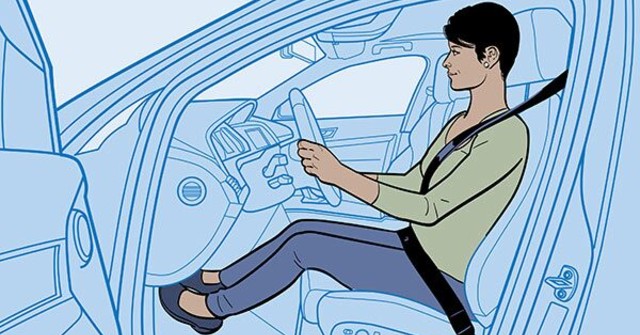
Having a comfortable seating position in a car enhances comfort and promotes better reactions to unexpected situations, increasing safety.
Prior to adjusting the driver’s seat, it is important to first ensure that your sitting position is correctly aligned. Sit upright, with your back firmly against the backrest of the seat, eliminating any gap between the chair and your hips. Once you have achieved the proper sitting position, proceed to fine-tune the adjustments of the seat for optimal comfort.

2. Modify the distance between the driver’s seat and the brake pedal.
3. Alter the distance from the driver’s seat to the brake pedal.
4. Change the spacing between the driver’s seat and the brake pedal.
5. Adapt the distance between the driver’s seat and the brake pedal.
6. Revise the distance from the driver’s seat to the brake pedal.
7. Amend the spacing between the driver’s seat and the brake pedal.
8. Fine-tune the distance from the driver’s seat to the brake pedal.
9. Regulate the spacing between the driver’s seat and the brake pedal.
10. Modify the distance separating the driver’s seat and the brake pedal.
11. Adjust the gap between the driver’s seat and the brake pedal.
12. Alter the distance from the driver’s seat to the brake pedal accordingly.
13. Adapt the gap between the driver’s seat and the brake pedal as required.
14. Revise the distance from the driver’s seat to the brake pedal accordingly.
15. Amend the distance separating the driver’s seat and the brake pedal as necessary.
16. Fine-tune the gap between the driver’s seat and the brake pedal according to specifications.
17. Regulate the distance from the driver’s seat to the brake pedal in accordance with guidelines.
18. Modify the spacing between the driver’s seat and the brake pedal based on recommendations.
19. Adjust the distance from the driver’s seat to the brake pedal to meet safety standards.
20. Change the separation between the driver’s seat and the brake pedal to ensure optimal comfort.
To find the perfect driver’s seat position, it is important to first familiarize yourself with the brake pedal travel of the vehicle. Start the car engine and engage the brakes fully a few times. Following this, adjust the seat in a manner that allows for a slight bend in your knees when the brake pedal is fully depressed. Ideally, your lower leg and thigh should form a 120-degree angle for optimal comfort.


It is important to adjust your seat in a way that avoids extremes. Avoid placing the seat too far back, as this can cause your legs to fully extend or lift your heels off the floor when you brake. This limits your control over the pedals and increases the risk of accidents. However, keeping the seat too close will result in your knees touching the bottom edge of the steering wheel, which will hinder your ability to handle the vehicle effectively.

Another factor to consider is that there should be a gap between the driver’s seat cushion and the inside of the knee. It is recommended to maintain a distance of two fingers, which can be easily verified with reference to the image provided.
Please make necessary adjustments to the height of the chair.
The seat’s height should be adjusted properly to ensure that the driver has an optimal view of the road and surroundings. Moreover, this adjustment enhances the driver’s comfort and minimizes any potential negative impacts from long-term seating.

To ensure a comfortable driving position, it is ideal for your hips to be level or slightly above your knees. Your elbows should touch the door sill, while your knees should not touch the bottom edge of the steering wheel. If adjusting the driver’s seat height does not solve the issue or if your vehicle lacks a seat lift feature, you may need to purchase an additional cushion for added support.
Change the angle of the backrest
To properly adjust the chair backrest, ensure that the middle of your back is in direct contact with it. For convenient adjustment, place your hands on the highest point of the steering wheel and then modify the backrest accordingly. Ensure that your elbows are slightly bent downwards and that your arms are parallel to the floor.

Research suggests that the ideal posture is achieved when the backrest and seat cushion form an angle of 100 to 110 degrees. This specific tilt allows for the least amount of pressure on the discs in the back, while also providing the driver with comfortable control over the steering wheel.
Modify the headrest’s height.
Drivers frequently neglect to adjust the headrest due to the misconception that it is inconsequential. Nevertheless, if positioned correctly, this vital accessory can effectively alleviate neck strain and potentially prevent neck injuries in case of a collision.

The ideal position for the headrest is to have the top edge at the same level as the top of the driver’s head. Additionally, there should be a distance of approximately 2 to 3cm between the headrest and the back of the driver’s neck.
5. Adjust the backrest pump
In the past, backrest pumps were exclusively found in high-end car models. However, they have recently been introduced in mid-range models as well. The purpose of this feature is to ensure maximum driving comfort and protect the driver’s spine in the long run by aligning with the natural concave part of their lower back.

To adjust the backrest pump, follow these two steps. Firstly, align the pump to the natural concave shape of your back by adjusting it up or down accordingly. Secondly, pump it up to fill in this hollow area. In case your car doesn’t have a built-in backrest pump, you can purchase a separate backrest pillow but make sure it fits your back properly.
6. Adjust the steering wheel
The position of the steering wheel, much like the seat, plays a crucial role in determining your driving position and overall safety. To properly adjust the distance of the steering wheel, place your hand on the highest point of the wheel and adjust it until your arm is fully extended and straight. To adjust the height of the steering wheel, compare the position of the lowest point on the wheel with your navel, making sure the distance between them is approximately one hand’s width, which is approximately 20 cm.

Furthermore, it is essential to synchronize the adjustment of the steering wheel with that of the driver’s seat in order to optimize visibility of the speedometer. Envision the steering wheel taking the form of a clock, where the most secure and convenient hand positions are at 3 o’clock and 9 o’clock.
Additionally, drivers have the option to enhance their driving and commuting experiences by utilizing massage cushions and cooling cushions. These cushions can be attached to the steering wheel or directly installed onto the seat, allowing users to enjoy their benefits while unwinding and recuperating after a long and taxing workday.
- Safe driving skills when it rains


